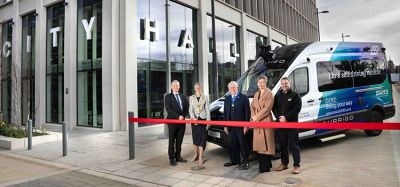TETRA – a global standard
- Like
- Digg
- Del
- Tumblr
- VKontakte
- Buffer
- Love This
- Odnoklassniki
- Meneame
- Blogger
- Amazon
- Yahoo Mail
- Gmail
- AOL
- Newsvine
- HackerNews
- Evernote
- MySpace
- Mail.ru
- Viadeo
- Line
- Comments
- Yummly
- SMS
- Viber
- Telegram
- Subscribe
- Skype
- Facebook Messenger
- Kakao
- LiveJournal
- Yammer
- Edgar
- Fintel
- Mix
- Instapaper
- Copy Link
Posted: 28 October 2009 | Bernt Mattsson, TETRA Technical Officer, European Telecommunications Standards Institute (ETSI) | No comments yet
Terrestrial Trunked Radio (TETRA) is the most successful digital trunking standard for professional users. Users of Private Mobile Radio (PMR) and Public Access Mobile Radio (PAMR) technology include police, ambulance and fire services, security services, utilities, military, public access, transport services, airports, factory site services, mining and the like. These user groups have special needs for mission or business critical communication solutions.
Terrestrial Trunked Radio (TETRA) is the most successful digital trunking standard for professional users. Users of Private Mobile Radio (PMR) and Public Access Mobile Radio (PAMR) technology include police, ambulance and fire services, security services, utilities, military, public access, transport services, airports, factory site services, mining and the like. These user groups have special needs for mission or business critical communication solutions.
Terrestrial Trunked Radio (TETRA) is the most successful digital trunking standard for professional users. Users of Private Mobile Radio (PMR) and Public Access Mobile Radio (PAMR) technology include police, ambulance and fire services, security services, utilities, military, public access, transport services, airports, factory site services, mining and the like. These user groups have special needs for mission or business critical communication solutions.
When the PMR/PAMR industry brought their initial ideas for TETRA to the European Telecommunications Standards Institute (ETSI) in the early 1990s, the focus was principally on establishing a single technology in response to demands from the European Commission. At that time, ETSI was producing standards primarily for the European market, but global interest in other technologies being standardised in ETSI (notably GSM) soon changed that view and stirred the aspirations of European industry.
Since TETRA was first deployed in 1997, well over 2,250 contracts have been let (to 2009) for TETRA networks worldwide. By 2009, TETRA has been deployed in over 105 countries worldwide, of which the majority (64%) are outside Europe, with Asia Pacific and Africa being the fastest developing regions (statistics from 2009, source TETRA Association). Nationwide government-operated mission critical TETRA networks have been in operation in Europe for many years and many other governments outside Europe are also basing their Government Radio Networks (GRN) on the TETRA standard.
The requirement was to create a digital wireless communications technology for emergency services, such as police, fire fighters and medical response units. The resulting specifications defined a very functional technology that can provide encryption, simultaneous voice and data communications, emergency call facilities, very fast call set-up times (less than a third of a second), group communication, call prioritisation and be able to work independent of the infrastructure (which includes the base stations). The TETRA standard offers a scalable architecture allowing economic network deployments ranging from single site local area to national and even multi-national networks. The evolution of the TETRA technology has also benefited from being a member of the ‘ETSI family’, facilitating interworking between TETRA and public networks (mostly specified by ETSI), and the use of innovations such as the SIM (Subscriber Identity Module) card, specified by ETSI originally for GSM.
The largest market for TETRA continues to be national public safety organisations deploying TETRA for networks shared by its emergency services. TETRA also continues to be deployed in all other traditional PMR markets, such as transportation, utilities, industrial and PAMR (commercial two-way business radio), as well as in the military sector for peace-keeping and other non-tactical activities. Figure 1 shows the relative sizes of these sectors currently.
Transportation is a growing sector. TETRA finds application in this sector in a number of areas, for example with buses where alongside normal voice communications and broadcast traffic information it can provide both real-time location information to its traffic-control centre, and update passengers with arrival and departure information that is made available via intelligent roadside at-stop displays.
In airports the group call facilities of TETRA are ideal for co-ordinating communications and work scheduling by flight number such that all the relevant teams servicing a flight can communicate together.
For taxis, applications have been developed that allow traffic analysis and efficiency in deployment.
In mass transit metro and rail systems TETRA is enabling improved efficiency, service and safety alongside increased passenger information.
Underpinning these examples is the ability of TETRA to offer, with specialist system integrators, highly customised operational solutions that resolve the complex communication challenges faced by modern public transport organisations. Flexible design enables systems integrators to simply transfer data via TETRA as status messages, Short Data Service (SDS) or IP packet data; in addition they can build console display emulations into their computer applications to take full control of the radio for both voice and data. Centralised control is the key to de-cluttering cramped vehicle cabs and makes it possible for integrators to build intelligent solutions.
The technology
The TETRA technology offers many advantages that include fast call set-up time, excellent group communication support, Direct Mode Operation (DMO) between radios, packet data and SDS, frequency economy, first-class voice quality and excellent security features. TETRA uses Time Division Multiple Access (TDMA) technology with four user channels on each 25 kHz of the allocated radio spectrum. This makes it inherently very efficient in the way that it uses the frequency spectrum.
The TETRA trunking facility provides a pooling of all radio channels which are then allocated on demand to individual users, in both voice and data modes. By the provision of national and multi-national networks, national and international roaming can be supported, the user being in constant seamless communications with his colleagues.
TETRA supports point-to-point and point-to-multipoint communications both by the use of the TETRA infrastructure and by the use of Direct Mode without infrastructure. TETRA is an interoperability standard with support from many vendors; compared with proprietary solutions this gives users considerable advantages in the form of greater choice and lower price.
Frequency allocation
Wireless communication systems inevitably need the use of radio spectrum, a scarce and valuable resource. Co-ordination of the use of spectrum is generally established within geographical regions, such as is the case in Europe. However, the ultimate aim is to achieve common frequencies worldwide since the establishment of commonly-agreed global allocations facilitates manufacture and deployment, reducing costs and enabling global roaming by users. ETSI has a leading role in co-ordinating and contributing industry requirements to the European (and, ultimately, global) process for the allocation of radio spectrum.
For emergency systems in Europe, the frequency bands 380-385 MHz and 390-395 MHz have been allocated for use by digital land mobile systems by the European Communication Office. For civil systems in Europe the frequency bands 410-430 MHz, 450-470 MHz have been allocated for TETRA.
A further important milestone was the publication of ECC decision ECC/DEC(08)05 for wide band Public Protection and Disaster Relief (PPDR) radio applications. This decision on the harmonisation of frequency bands for the implementation of digital PPDR radio applications in bands within the 380-470 MHz range indicates a clear commitment by the European national administrations to support broadband wide area Public Safety and Security PPDR radio applications. This is of particular importance for ‘Release 2′ of the TETRA standards where one of the main features is the TETRA Enhanced Data Service (TEDS).
TEDS supports radio channel widths of 25 kHz, 50 kHz, 100 kHz and 150 kHz and allows user bit rates between 30 and 400 kbit/s depending on which bandwidth is being chosen and on the distance from the base station. TEDS will hence have a major positive impact on the long-anticipated move to data intensive applications for mission critical users and others.
TETRA ‘Release 2′ includes various other improvements, including extension to the cell range from 58km to 83km and a common format protocol for positioning services, known as the Location Information Protocol (LIP).
Whilst many of these enhancements are primarily in response to the requirements of TETRA’s mission-critical users, they will of course benefit other demanding users as well.
Standardising TETRA
The production of the standards for TETRA is the task of ETSI’s TETRA Technical Committee. The work is performed in close collaboration with the TETRA Association, an industry organisation representing users, manufacturers, application providers, integrators, operators, test houses and telecommunication agencies – in all, more than 150 organisations from all corners of the world. This collaboration ensures that the standardised solutions meet the current and foreseen expectations of all parts of the TETRA community, thus helping to future-proof the TETRA technology.
Within the ETSI technical committee, over 150 technical specialists from ETSI member companies participate in working groups that focus on specific topics, such as user requirements, network aspects, high-speed data, voice coding, security and Direct Mode Operation (DMO).
The TETRA technology continues to evolve and it is the task of the ETSI committee to evolve the TETRA standards accordingly, with the following aims:
- Provision of user-driven services, facilities and functionality as required by traditional PMR user organisations such as the emergency services, government, military, transportation, utility and industrial organisations, as well as PAMR operators
- Evolution and enhancement of TETRA as required by the market with the provision of new services, facilities and functionality made possible by technological innovations and standards
- Enhancements to provide increased benefits and optimisation in terms of spectrum efficiency, network capacity, system performance, quality of service, security and other relevant parameters
- Backward compatibility and integration of the services, facilities and functionality with existing TETRA standards in order to future-proof the existing and future investments of TETRA users
The work of TETRA committee complements other ETSI standards activity relating to emergency response communications. ETSI’s EMTEL committee is responsible for identifying and co-ordinating the operational and technical requirements of those involved in the provision of emergency communications.
All of this work relies on the involvement and feedback of users, operators, regulators and manufacturers who are invited to participate in the open standards process. ETSI produces globally-applicable standards for Information and Communications Technologies (ICT), including fixed, mobile, radio, converged, broadcast, vehicular, maritime, aeronautical and internet technologies, and is officially recognised by the European Union as a European Standards Organisation. ETSI is an independent, not-for-profit association whose 766 member companies and organisations, drawn from 63 countries across five continents worldwide, determine its work programme and participate directly in its work.




Related topics
5G & Transport Communications
Issue
Issue 5 2009
Related organisations
European Telecommunications Standards Institute (ETSI)
Related people
Bernt Mattsson








